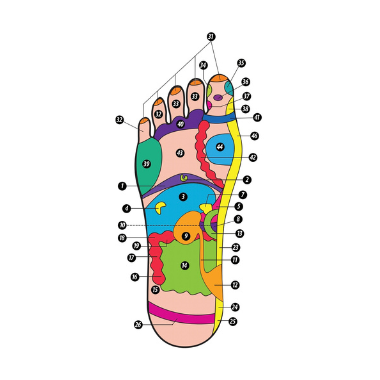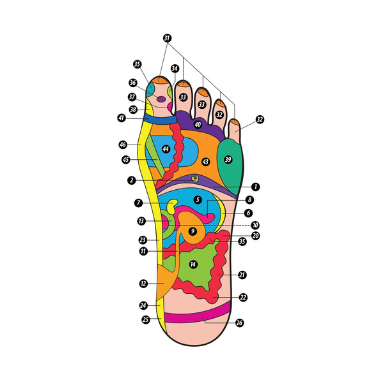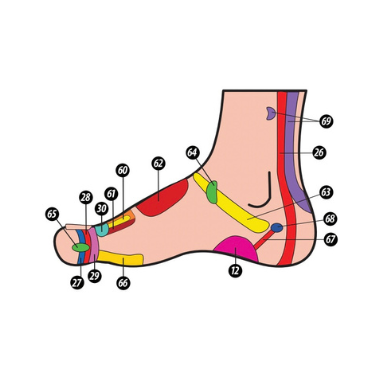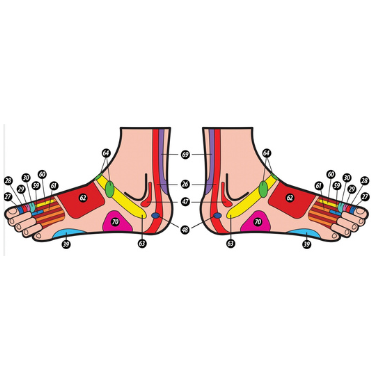What is Reflexology?
The process of reflexology involves focusing pressure on the feet and hands. In reflexology, areas on the feet and hands correspond to organs and parts of the body via the nervous system. For example, a place on the right side of your foot corresponds with your shoulder and arm, whereas an area on the arch of your feet corresponds with your kidneys, liver, and pancreas. At Natural Balance, we use various techniques to massage and apply pressure to the feet to improve circulation, detoxify the body, and relieve stress.
How Reflexology can help
Areas Reflexology can help
- Stress and Tension
- Helping Improve Mood
- Aids Sleep
- Improves a Sense of Well-being
- Helping with Relaxation
Reflexes are areas on the feet that the Reflexologist will provide treatment to, which are linked to other areas of your body and nervous system. Applying pressure to the hands, feet & ears can help your well-being.
Some people advise that the following treatment, they feel lower levels of anxiety and calmer.
What others are saying...
- Pain reduction
- Improved Circulation
- Stress
- Time to relax
- Hard day on your feet
Often called zone therapy, reflexology is an alternative medicine that few people understand. The name ‘Zone Therapy’ comes from the system of zones and reflexes found on your hands, feet, and ears. Physical aspects of the body are claimed to be helped by these systems of zones and reflex areas. Currently, there is no evidence to support the effectiveness of this treatment.
Had reflexology with Emily today. Wonderful, very relaxing. Highly recommended. Many thanks. Jo
Jo - Verified Natural Balance Customer
★★★★★ 5/5
- 1 Diaphragm
- 2 Solar Plexus
- 3 Liver
- 4 Gallbladder
- 5 Stomach
- 6 Spleen
- 7 Adrenals
- 8 Pancreas
- 9 Kidney
- 10 Waist Line
- 11 Ureter Tube
- 12 Bladder
- 13 Doudenum
- 14 Small Intestine
- 15 Appendix
- 16 Ileocecal Valve
- 17 Ascending Colon
- 18 Hepatic Flexure
- 19 Transverse Colon
- 20 Splenic Flexure
- 21 Desecending Colon 22 Sigmoid Colon
- 23 Lumbar Spine
- 24 Sacral Spine
- 25 Coccyx
- 26 Sciatic Nerve
- 27 Upper Jaw/Teeth/Gums
- 28 Lower Jaw/Teeth/Gums
- 29 Neck/Throat/Tonsils 30 Vocal Chords
- 30 Vocal Chords
- 31 Brain
- 32 Sinuses/Outer Ear
- 33 Sinuses/Inner Ear
- 34 Temple
- 35 Pineal/Hypothalamus
- 36 Pituitary
- 37 Side Of Neck
- 38 Cervical Spine
- 39 Shoulder/Arm
- 40 Neck/Helper To Eye Inner Ear
- 41 Neck/Thyroid/Tonsils
- 42 Bronchial/Thyroid Helper
- 43 Chest/Lung
- 44 Heart
- 45 Esophagus
- 46 Thoracic Spine
- 47 Hip / Lower Back / Sciatic
- 48 Ovaries / Testes
- 59 Lymph/Breast/Chest
- 60Chest/Breast/MammaryGlands 61 MidBack
- 62 Fallopian Tube/Vas Deferens
- 63 Lymph/Groin
- 64 Nose
- 65 Thymus
- 66 Penis/Vagina
- 67 Uterus/Prostate
- 68 Chronic AreaReproductive/Rectum
- 69 LowerBackHelper
- 70 Knee






